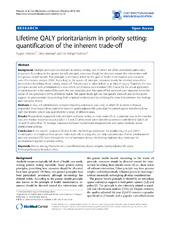| dc.contributor.author | Ottersen, Trygve | en_US |
| dc.contributor.author | Mæstad, Ottar | en_US |
| dc.contributor.author | Norheim, Ole Frithjof | en_US |
| dc.date.accessioned | 2014-09-16T11:10:53Z | |
| dc.date.available | 2014-09-16T11:10:53Z | |
| dc.date.issued | 2014-01-14 | eng |
| dc.identifier.issn | 1478-7547 | |
| dc.identifier.uri | https://hdl.handle.net/1956/8487 | |
| dc.description.abstract | Background: Multiple principles are relevant in priority setting, two of which are often considered particularly important. According to the greater benefit principle, resources should be directed toward the intervention with the greater health benefit. This principle is intimately linked to the goal of health maximization and standard cost-effectiveness analysis (CEA). According to the worse off principle, resources should be directed toward the intervention benefiting those initially worse off. This principle is often linked to an idea of equity. Together, the two principles accord with prioritarianism; a view which can motivate non-standard CEA. Crucial for the actual application of prioritarianism is the trade-off between the two principles, and this trade-off has received scant attention when the worse off are specified in terms of lifetime health. This paper sheds light on that specific trade-off and on the public support for prioritarianism by providing fresh empirical evidence and by clarifying the close links between the findings and normative theory. Methods: A new, self-administered, computer-based questionnaire was used, to which 96 students in Norway responded. How respondents wanted to balance quality-adjusted life years (QALYs) gained against benefiting those with few lifetime QALYs was quantified for a range of different cases. Results: Respondents supported both principles and were willing to make trade-offs in a particular way. In the baseline case, the median response valued a QALY 3.3 and 2.5 times more when benefiting someone with lifetime QALYs of 10 and 25 rather than 70. Average responses harbored fundamental disagreements and varied modestly across distributional settings. Conclusion: In the specific context of lifetime health, the findings underscore the insufficiency of pure QALY maximization and explicate how people make trade-offs in a way that can help operationalize lifetime prioritarianism and non-standard CEA. Seen through the lens of normative theory, the findings highlight key challenges for prioritarianism applied to priority setting. | en_US |
| dc.language.iso | eng | eng |
| dc.publisher | BioMed Central | eng |
| dc.rights | Attribution CC BY | eng |
| dc.rights.uri | http://creativecommons.org/licenses/by/2.0 | eng |
| dc.subject | Priority setting | eng |
| dc.subject | Prioritarianism | eng |
| dc.subject | Cost-effectiveness | eng |
| dc.subject | Equity weights | eng |
| dc.subject | Quality-adjusted life years | eng |
| dc.subject | Political philosophy | eng |
| dc.subject | Empirical ethics | eng |
| dc.title | Lifetime QALY prioritarianism in priority setting: quantification of the inherent trade-off | en_US |
| dc.type | Peer reviewed | |
| dc.type | Journal article | |
| dc.date.updated | 2014-04-02T10:41:04Z | |
| dc.description.version | publishedVersion | en_US |
| dc.rights.holder | Copyright 2014 Ottersen et al.; licensee BioMed Central Ltd. | |
| dc.rights.holder | Trygve Ottersen et al.; licensee BioMed Central Ltd. | |
| dc.source.articlenumber | 2 | |
| dc.identifier.doi | https://doi.org/10.1186/1478-7547-12-2 | |
| dc.identifier.cristin | 1163154 | |
| dc.source.journal | Cost Effectiveness and Resource Allocation | |
| dc.source.40 | 12 | |

